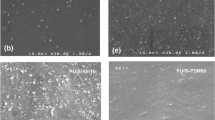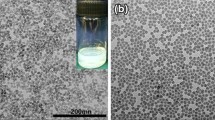Abstract
The main purpose of this research is to assess the effectiveness of precipitated nano-silica on mechanical properties and icephobicity of hydroxyl-terminated polydimethylsiloxane (HT-PDMS). It also tries to shed light on the correlation between mechanical characteristics and icephobicity of the abovementioned nanocomposites. In this regard, an icephobic coating was designed based on hydroxyl-terminated polydimethylsiloxane (HT-PDMS) elastomer through the sol–gel method with an emphasis on mechanical properties enhancement and durability. The quantity of precipitated nano-silica domains in HT-PDMS hybrid coatings was meticulously tailored by utilizing various ratios of tetraethyl orthosilicate (TEOS) and pre-hydrolyzed TEOS as silica domain precursors. It was established that using pre-hydrolyzed TEOS facilitated nano-silica precipitation and improved the coating’s thermal stability and mechanical properties. Nano-silica precipitation was detected by thermogravimetric analysis (TGA) and confirmed by scanning electron microscopy (SEM). The abundance of nanosized silica particles precipitated by TEOS hydrolysis and condensation was <5%, while >20% in the nanocomposite sample precipitated by using pre-hydrolyzed TEOS. Tensile measurements indicated that greater silica precipitation enhanced tensile strength, elongation at break, and Young’s modulus. The push-off test confirmed the very low shear ice adhesion strength (30–40 kPa) and the icephobic nature of the coatings. However, it was demonstrated that mechanical enhancement is correlated to ice adhesion strength up to 13.6% silica content, and icephobicity would be sacrificed at higher contents. Icing–deicing testing reveals that despite the initial ice adhesion strength increase by higher silica content, coatings present very better durability after repetitive cycles in greater silica value.
Graphical abstract

Highlights
-
The quantities of precipitated nano-silica domains are tailored by using prehydrolyzed TEOS and TEOS as inorganic precursors.
-
Mechanically and thermally enhanced HT-PDMS-based coating is developed by silica precipitation.
-
The correlation between Young’s modulus and ice adhesion strength for nanocomposite elastomers is investigated.
-
Mechanical enhancement and icephobicity is optimized for silica-precipitated HT-PDMS nanocomposite.











Similar content being viewed by others
References
Shamshiri M, Jafari R, Momen G (2021) Icephobic properties of aqueous self-lubricating coatings containing PEG–PDMS copolymers. Prog Org Coat 161:106466. https://doi.org/10.1016/j.porgcoat.2021.106486
Jung S, Tiwari MK, Doan NV, Poulikakos D (2012) Mechanism of supercooled droplet freezing on surfaces. Nat Commun 3:1–8. https://doi.org/10.1038/ncomms1630
Jafari R, Momen G, Farzaneh M (2016) Durability enhancement of icephobic fluoropolymer film. J Coat Technol Res 13:405–412. https://doi.org/10.1007/s11998-015-9759-z
Yeong YH, Milionis A, Loth E, Sokhey J (2018) Self-lubricating icephobic elastomer coating (SLIC) for ultralow ice adhesion with enhanced durability. Cold Reg Sci Technol 148:29–37. https://doi.org/10.1016/j.coldregions.2018.01.005
Mulherin ND, Haehnel RB. Ice engineering: progress in evaluating surface coatings for icing control at corps hydraulic structures. Hanover, NH: Army Engineer Research and Development Center; 2003
Momen G, Jafari R, Farzaneh M (2015) Ice repellency behavior of superhydrophobic surfaces: effects of atmospheric icing conditions and surface roughness. Appl Surf Sci 349:211–218. https://doi.org/10.1016/j.apsusc.2015.04.180
Shamshiri M, Jafari R, Momen G (2021) Potential use of smart coatings for icephobic applications: a review. Surf Coat Technol 424:127656. https://doi.org/10.1016/j.surfcoat.2021.127656
Jung S, Dorrestijn M, Raps D, Das A, Megaridis CM, Poulikakos D (2011) Are superhydrophobic surfaces best for icephobicity. Langmuir 27:3059–3066. https://doi.org/10.1021/la104762g
Antonini C, Innocenti M, Horn T, Marengo M, Amirfazli A (2011) Understanding the effect of superhydrophobic coatings on energy reduction in anti-icing systems. Cold Reg Sci Technol 67:58–67. https://doi.org/10.1016/j.coldregions.2011.02.006
Yancheshme AA, Momen G, Aminabadi RJ (2020) Mechanisms of ice formation and propagation on superhydrophobic surfaces: a review. Adv Colloid Interface Sci 279:102155. https://doi.org/10.1016/j.cis.2020.102155
Maghsoudi K, Vazirinasab E, Momen G, Jafari R (2021) Icephobicity and durability assessment of superhydrophobic surfaces: the role of surface roughness and the ice adhesion measurement technique. J Mater Process Technol 288:116883. https://doi.org/10.1016/j.jmatprotec.2020.116883
Moriya T, Manabe K, Tenjimbayashi M, Suwabe K, Tsuchiya H, Matsubayashi T, Navarrini W, Shiratori S (2016) A superrepellent coating with dynamic fluorine chains for frosting suppression: effects of polarity, coalescence and ice nucleation free energy barrier. RSC Adv 6:92197–92205. https://doi.org/10.1039/C6RA18483A
Shen Y, Wu Y, Tao J, Zhu C, Chen H, Wu Z, Xie Y (2018) Spraying fabrication of durable and transparent coatings for anti-icing application: dynamic water repellency, icing delay, and ice adhesion. ACS Appl Mater Interfaces 11:3590–3598. https://doi.org/10.1021/acsami.8b19225
Zhu T, Cheng Y, Huang J, Xiong J, Ge M, Mao J, Liu Z, Dong X, Chen Z, Lai Y (2020) A transparent superhydrophobic coating with mechanochemical robustness for anti-icing, photocatalysis and self-cleaning. Chem Eng J 399:125746. https://doi.org/10.1016/j.cej.2020.125746
Guerin F, Laforte C, Farinas M-I, Perron J (2016) Analytical model based on experimental data of centrifuge ice adhesion tests with different substrates. Cold Reg Sci Technol 121:93–99. https://doi.org/10.1016/j.coldregions.2015.10.011
Jamil MI, Zhan X, Chen F, Cheng D, Zhang Q (2019) Durable and scalable candle soot icephobic coating with nucleation and fracture mechanism. ACS Appl Mater Interfaces 11:31532–31542. https://doi.org/10.1021/acsami.9b09819
Zhuo Y, Xiao S, Amirfazli A, He J, Zhang Z. Polysiloxane as icephobic materials—the past, present and the future. Chem Eng J 405:127088. https://doi.org/10.1016/j.cej.2020.127088
Nosonovsky M, Hejazi V (2012) Why superhydrophobic surfaces are not always icephobic. ACS Nano 6:8488–8491. https://doi.org/10.1021/nn302138r
Owen MJ (2001) Elastomers: siloxane. In: Jürgen Buschow KH, Cahn RW, Flemings MC, Ilschner B, Edward JK, Mahajan S, Veyssière P (eds.), Encyclopedia of materials: science and technology, Elsevier 2480–2482. https://doi.org/10.1016/B0-08-043152-6/00448-4
Zhuo Y, Håkonsen V, He Z, Xiao S, He J, Zhang Z (2018) Enhancing the mechanical durability of icephobic surfaces by introducing autonomous self-healing function. ACS Appl Mater Interfaces 10:11972–11978. https://doi.org/10.1021/acsami.8b01866
Yuan QW, Mark JE (1999) Reinforcement of poly (dimethylsiloxane) networks by blended and in‐situ generated silica fillers having various sizes, size distributions, and modified surfaces. Macromol Chem Phys 200:206–220. https://doi.org/10.1002/(SICI)1521-3935(19990101)
Paul DR, Mark JE (2010) Fillers for polysiloxane (“silicone”) elastomers. Prog Polym Sci 35:893–901. https://doi.org/10.1016/j.progpolymsci.2010.03.004
Zhiwei H, Zhuo Y, He J, Zhang Z (2014) Design and preparation of sandwich-like polydimethylsiloxane (PDMS) sponges with super-low ice adhesion. Soft Matter 14:4846–4851. https://doi.org/10.1039/C8SM00820E
Dou R, Chen J, Zhang Y, Wang X, Cui D, Song Y, Jiang L, Wang J (2014) Anti-icing coating with an aqueous lubricating layer. ACS Appl Mater Interfaces 6:6998–7003. https://doi.org/10.1021/am501252u
Kulinich SA, Farhadi S, Nose K, Du XW (2011) Superhydrophobic surfaces: are they really ice-repellent. Langmuir 27:25–29. https://doi.org/10.1021/la104277q
Sheng L, Wang F, Fang X, Ou J, Li W (2019) Icing behavior of water droplets impinging on cold superhydrophobic surface. Surf Coat Technol 363:362–368. https://doi.org/10.1016/j.surfcoat.2019.02.035
Arianpour F, Farzaneh M, Kulinich SA (2013) Hydrophobic and ice-retarding properties of doped silicone rubber coatings. Appl Surf Sci 265:546–552. https://doi.org/10.1016/j.apsusc.2012.11.042
Hejazi V, Sobolev K, Nosonovsky M (2013) From superhydrophobicity to icephobicity: forces and interaction analysis. Sci Rep 3:1–6. https://doi.org/10.1038/srep02194
Urata C, Dunderdale GJ, England MW, Hozumi A (2015) Self-lubricating organogels (SLUGs) with exceptional syneresis-induced anti-sticking properties against viscous emulsions and ices. J Mater Chem A 3:12626–12630. https://doi.org/10.1039/C5TA02690C
Subramanyam SB, Rykaczewski K, Varanasi KK (2013) Ice adhesion on lubricant-impregnated textured surfaces. Langmuir 29:13414–13418. https://doi.org/10.1021/la402456c
Chaudhury MK, Kim KH (2007) Shear-induced adhesive failure of a rigid slab in contact with a thin confined film. Eur Phys J E 23:175–183. https://doi.org/10.1140/epje/i2007-10171-x
Breiner JM, Mark JE, Beaucage G (1999) Dependence of silica particle sizes on network chain lengths, silica contents, and catalyst concentrations in in situ‐reinforced polysiloxane elastomers. J Polym Sci Part B: Polym Phys 37:1421–1427. 10.1002/(SICI)1099-0488(19990701)37:13<1421::AID-POLB8>3.0.CO;2-M
Schaefer DWT, Keefer KD (1984) Fractal geometry of silica condensation polymers. Phys Rev Lett 53:1383. https://doi.org/10.1103/PhysRevLett.53.1383
Mark JE, Pan S‐J (1982) Reinforcement of polydimethylsiloxane networks by in‐situ precipitation of silica: a new method for preparation of filled elastomers. Die Makromol Chem Rapid Commun 3:681–685. https://doi.org/10.1002/marc.1982.030031006
Ulibarri TA, Beaucage G, Schaefer DW, Olivier BJ, Assink RA (1992) Molecular weight dependence of domain structure in silica-siloxane molecular composites. MRS Online Proc Libr 274:85–90. https://doi.org/10.1557/PROC-274-85
Camenzind A, Schweizer T, Sztucki M, Pratsinis SE (2010) Structure & strength of silica-PDMS nanocomposites. Polymer 51:1796–1804. https://doi.org/10.1016/j.polymer.2010.02.030
Şerbescu A, Saalwächter K (2009) Particle-induced network formation in linear PDMS filled with silica. Polymer 50:5434–5442. https://doi.org/10.1016/j.polymer.2009.09.063
Sobhani S, Bastani S, Gedde UW, Sari MG, Ramezanzadeh B (2017) Network formation and thermal stability enhancement in evolutionary crosslinked PDMS elastomers with sol–gel-formed silica nanoparticles: comparativeness between as-received and pre-hydrolyzed TEOS. Prog Org Coat 113:117–125. https://doi.org/10.1016/j.porgcoat.2017.08.012
Bakhshandeh E, Jannesari A, Ranjbar Z, Sobhani S, Saeb MR (2014) Anti-corrosion hybrid coatings based on epoxy–silica nano-composites: toward relationship between the morphology and EIS data. Prog Org Coat 77:1169–1183. https://doi.org/10.1016/j.porgcoat.2014.04.005
Golovin K, Kobaku SPR, Lee DH, DiLoreto ET, Mabry JM, Tuteja A (2016) Designing durable icephobic surfaces. Sci Adv 2:1501496. https://doi.org/10.1126/sciadv.1501496
Wong T-S, Kang SH, Tang SKY, Smythe EJ, Hatton BD, Grinthal A, Aizenberg J (2011) Bioinspired self-repairing slippery surfaces with pressure-stable omniphobicity. Nature 477:443–447. https://doi.org/10.1038/nature10447
Kendall K (1971) The adhesion and surface energy of elastic solids. J Phys D: Appl Phys 4:1186. https://doi.org/10.1088/0022-3727/4/8/320
Wang C, Fuller T, Zhang W, Wynne KJ (2014) Thickness dependence of ice removal stress for a polydimethylsiloxane nanocomposite: Sylgard 184. Langmuir 30:12819–12826. https://doi.org/10.1021/la5030444
Yao H, Gao H (2010) Gibson-soil-like materials achieve flaw-tolerant adhesion. J Comput Theor Nanosci 7:1299–1305. https://doi.org/10.1166/jctn.2010.1484
Kaffashi A, Jannesari A, Ranjbar Z (2012) Silicone fouling-release coatings: effects of the molecular weight of poly (dimethylsiloxane) and tetraethyl orthosilicate on the magnitude of pseudobarnacle adhesion strength. Biofouling 28:729–741. https://doi.org/10.1080/08927014.2012.702342
Sohoni GB, Mark JE (1992) Thermal stability of in situ filled siloxane elastomers. J Appl Polym Sci 45:1763–1775. https://doi.org/10.1002/app.1992.070451010
Schaefer DW, Suryawanshi C, Pakdel P, Ilavsky J, Jemian PR (2002) Challenges and opportunities in complex materials: silica-reinforced elastomers. Physica A 314:686–695. https://doi.org/10.1016/S0378-4371(02)01190-1
Golovin K, Tuteja A (2017) A predictive framework for the design and fabrication of icephobic polymers. Sci Adv 3:e1701617. https://doi.org/10.1126/sciadv.1701617
Xu M, Zhao Y, Zhang X, Li Z, Zhao L, Wang Z, Gao W (2019) Highly homogeneous polysiloxane flexible coating for low earth orbital spacecraft with ultraefficient atomic oxygen resistance and self-healing behavior. ACS Appl Polym Mater 1:3253–3260. https://doi.org/10.1021/acsapm.9b00671
Liu Y, Ma L, Wang W, Kota AK, Hu H (2018) An experimental study on soft PDMS materials for aircraft icing mitigation. Appl Surf Sci 447:599–609. https://doi.org/10.1016/j.apsusc.2018.04.032
Langleben MP (1962) Young’s modulus for sea ice. Can J Phys 40:1–8. https://doi.org/10.1139/p62-001
Wang Z (2011) Polydimethylsiloxane mechanical properties measured by macroscopic compression and nanoindentation techniques. Graduate theses and Dissertations, University of South Florida
Meuler AJ, Smith JD, Varanasi KK, Mabry JM, McKinley GH, Cohen RE (2010) Relationships between water wettability and ice adhesion. ACS Appl Mater Interfaces 2:3100–3131. https://doi.org/10.1021/am1006035
Acknowledgements
The authors would like to acknowledge with gratitude the Natural Sciences and Engineering Research Council of Canada (NSERC) and Hydro-Québec who kindly supported this work financially.
Author information
Authors and Affiliations
Corresponding author
Ethics declarations
Conflict of interest
The authors declare no competing interests.
Additional information
Publisher’s note Springer Nature remains neutral with regard to jurisdictional claims in published maps and institutional affiliations.
Rights and permissions
Springer Nature or its licensor (e.g. a society or other partner) holds exclusive rights to this article under a publishing agreement with the author(s) or other rightsholder(s); author self-archiving of the accepted manuscript version of this article is solely governed by the terms of such publishing agreement and applicable law.
About this article
Cite this article
Sobhani, S., Bakhshandeh, E., Jafari, R. et al. Mechanical properties, icephobicity, and durability assessment of HT-PDMS nanocomposites: Effectiveness of sol–gel silica precipitation content. J Sol-Gel Sci Technol 105, 348–359 (2023). https://doi.org/10.1007/s10971-022-06033-2
Received:
Accepted:
Published:
Issue Date:
DOI: https://doi.org/10.1007/s10971-022-06033-2




